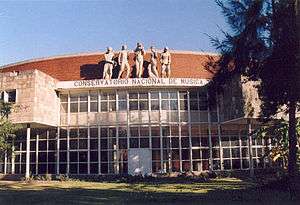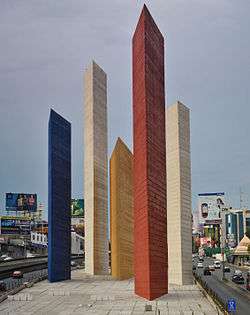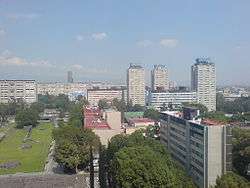Mario Pani
Mario Pani Darqui (March 29, 1911 – February 23, 1993) was a famous Mexican architect and urbanist. He was one of the most active urbanists under the Mexican Miracle, and gave form to a good part of the urban appearance of Mexico City, with emblematic buildings (nowadays characteristic of Mexico City), such as the main campus of the UNAM, the Unidad Habitacional Nonoalco-Tlatelolco (following Le Corbusier's urban principles), the Normal School of Teachers (Mexico), the National Conservatory of Music and other big housing projects called multifamiliares. His son Knut is a well-known artist.
Mario Pani Darqui | |
|---|---|
| Born | March 29, 1911 |
| Died | February 23, 1993 (aged 81) Mexico City, Mexico |
| Nationality | Mexican |
| Alma mater | École nationale supérieure des Beaux-Arts, National Autonomous University of Mexico |
Notable work | University City of the UNAM, Mexico, Unidad Habitacional Nonoalco-Tlatelolco |
| Awards | National Prize for Arts and Sciences (Mexico) (1986) |
Career
Mario Pani was born in Mexico City. He studied architecture in France and Mexico, and later on he would found the National College of Architects (Mexico) in 1946. In 1938, he began the journal Arquitectura Mexico, which was published until 1979.[1] He introduced the international style in Mexico, and was the first promoter of big housing Tower block projects. Pani was a great innovator of the urban design of Mexico City, and was involved in the construction of some of its newer parts, developing or participating in the more ambitious and important city-developing plans of the 20th century in Mexico, like Ciudad Satélite (along with Domingo Garcia Ramos and Jose Luis Cuevas), Tlatelolco, the Juárez and Miguel Alemán tower blocks, and the condominium in Paseo de la Reforma, the first of its type in Mexico.
Works

Pani's works include:
- Hotel Reforma (Paseo de la Reforma at Paris street, Mexico City, 1936)
- Escuela Nacional de Maestros (Mexico City, 1945)
- National Conservatory of Music of Mexico (Mexico City, 1946)
- Hotel Plaza, now Secretariat of Urban Development and Housing
- Secretaria de Recursos Hidráulicos (Mexico City, 1946, currently Embassy Suites)
- Centro Urbano Presidente Alemán (Mexico City, 1949)
- Centro Urbano Presidente Juárez (Mexico City, 1950, more than 50% destroyed after the 1985 earthquake)
- Ciudad Universitaria of the UNAM (1950–1953) based on main plan designed by then student Teodoro Gonzalez de Leon
- Ciudad Satélite (1956–1952)
- Torre Insignia (Mexico City, 1962)
- Unidad Habitacional Nonoalco-Tlatelolco (Mexico City, 1964, severely damaged after the 1985 earthquake)
- Port of Entry, Nogales, Sonora
- Reforma 268 (condominium)
- Condominium on Río Guadalquivir between Paseo de la Reforma and Río Volga, Colonia Cuauhtémoc
Awards
- 1986: National Prize for Arts and Sciences "fine arts"
Tribute
On March 29, 2018, Google celebrated his 107th birthday with a Google Doodle.[2]
See also
- Modernist architecture in Mexico
Gallery
 Torre Insignia, a.k.a. Banobras Tower
Torre Insignia, a.k.a. Banobras Tower The Torres de Satélite, landmark of Ciudad Satélite, a Mexico City suburb
The Torres de Satélite, landmark of Ciudad Satélite, a Mexico City suburb Rectory Tower of the Ciudad Universitaria campus of the National Autonomous University of Mexico (UNAM), Mexico City
Rectory Tower of the Ciudad Universitaria campus of the National Autonomous University of Mexico (UNAM), Mexico City- Multifamiliar Miguel Alemán, Mexico City
 Condominium on Paseo de la Reforma and Ave. Río Guadalquivir, Mexico City
Condominium on Paseo de la Reforma and Ave. Río Guadalquivir, Mexico City- Hotel Reforma, Mexico City (1936)
- Hotel Plaza (1946), now Secretariat of Urban Development and Housing, Mexico City
 Ciudad Satélite (master plan), Greater Mexico City
Ciudad Satélite (master plan), Greater Mexico City Conjunto Urbano Nonoalco Tlatelolco, Mexico City
Conjunto Urbano Nonoalco Tlatelolco, Mexico City- Unidad Habitacional Santa Fé, Mexico City
 Unidad Habitacional Jamaica, Mexico City
Unidad Habitacional Jamaica, Mexico City.jpg) Reforma 368 (1956)
Reforma 368 (1956) Condominio Acero, Macroplaza, Monterrey
Condominio Acero, Macroplaza, Monterrey Parque España 55, Colonia Condesa, Mexico City, apartments tower.
Parque España 55, Colonia Condesa, Mexico City, apartments tower.
| Wikimedia Commons has media related to Mario Pani Darqui. |
References
- "Con los ojos de Mario Pani (With Mario Pani's eyes), in Spanish".
- "Mario Pani's 107th Birthday". Google. 29 March 2018.
Further reading
- Mario Pani. La construcción de la modernidad/ Miquel Adrià (Ediciones G.Gilli, S.A. de C.V.-CONACULTA, México, 2005)
- La idea del apartamento en México durante el Movimiento Moderno: El proyecto de habitación colectiva en la obra de Carlos Obregón Santacilia, Francisco J. Serrano y Mario Pani. Pérez-Duarte Fernandez, Alejandro (México: PUBLICIA, 2013). ISBN 3639551567